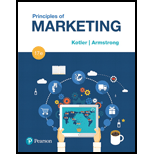
Principles of Marketing, Student Value Edition Plus MyLab Marketing with Pearson eText -- Access Card Package (17th Edition)
17th Edition
ISBN: 9780134642321
Author: Philip T. Kotler, Gary Armstrong
Publisher: PEARSON
expand_more
expand_more
format_list_bulleted
Concept explainers
Question
Chapter 8, Problem 8.12AC
Summary Introduction
Case summary:
One of the marketing ethics is the geographical indictor, which denotes the basis of foodstuffs. Country E has a big story of gastronomical delicacies, which the union of Country E has been waiting eagerly to safeguard due to economic reasons. The Government of Country GB is producing Product S to safeguard $4 billion industry from the imitators. However, everything comes with a larger price tag for the customers.
Characters in given case:
Country E
Country GB
To discuss: Whether the geographical indications provide advantages to the consumers or to the sellers.
Expert Solution & Answer
Want to see the full answer?
Check out a sample textbook solution
Students have asked these similar questions
In your expert opinion, what do you think is the most effective and efficient way for small business owners to promote and market their products/services? Why?
How have you seen the use of referrals and word of mouth advertising work to the benefit of a small business owner? Please would you kindly provide some examples. How have these methods worked in reverse (to the disadvantage of the owner but possibly benefit the competition)?
In your Expert Opinion, How do the risks differ when you start your business using a purely product development process versus a purely customer development process approach?
What are the elements that go into a customer profile and why is each one useful?
What are some of the ways that you could use secondary research to better understand the various segments of your market and to develop promotional materials?
What marketing challenges might arise should a major health care provider stop offering a product or service that is socially popular but economically unprofitable?
What marketing elements should be considered before a health care provider eliminates such a product or service?
Chapter 8 Solutions
Principles of Marketing, Student Value Edition Plus MyLab Marketing with Pearson eText -- Access Card Package (17th Edition)
Knowledge Booster
Learn more about
Need a deep-dive on the concept behind this application? Look no further. Learn more about this topic, marketing and related others by exploring similar questions and additional content below.Similar questions
- Choose a company, conduct an in-depth analysis of the identification of variables that are the target of the company's market segmentation, and provide examples of what the company has done to meet its targetsarrow_forwardTravel agencies lose business because passengers book their flights directly on airline websites. give me suggestion on the possible new business line options for passengers who wish to travel, so that the company can replace the loss of airline ticket sales at the agency.arrow_forwardOne of our favourite products is a mobile phone. One popular brand is the Clear Voice GA8. Theproduct is a midrange mobile handset with amazing features and benefits. Some of the phone’s iconicfeatures include a large 4 GB RAM, 166g weight, a durable Corning Gorilla Glass 3, 25MP cameras, anenhanced octa-core processor, 64GB of internal memory, fast battery charging, and fingerprint sensor.These features make the product an outstanding offering in the midrange phones market. Before itsrelease in 2019, purchasing a handset with similar features was a luxurious venture only left to theelite and wealthy persons in society.The product has a lot of benefits depending on the user. Users enjoy multiple benefits from the ClearVoice GA8. It does not lag due to the inclusion of Mali G72 MP3 in its processor (“A 8,” n.d.). As such,the product allows for the performance of multiple actions simultaneously. The gadget has anexpandable memory of up to 128GB. It, therefore, allows the user to save as…arrow_forward
- List and descrive apple products and services that they offer. What it foes and how much it cost. Include apple services like carplay partnered with car dealership, apple tv and apple play store and many more...arrow_forwardWhat is the direct materials quantity variance?arrow_forwardBeing upper management ECRHS and understanding the impact branding and competitive strategies have on consumer choice. Understanding that our \ goal as a marketing manager is to increase your organization’s appeal to the community. How can I Explain what impact brand had on the marketing strategy. along with Explaining what impact competitors had on the marketing strategy. Describing the relationship between consumer choice and chosen marketing strategies.arrow_forward
arrow_back_ios
SEE MORE QUESTIONS
arrow_forward_ios
Recommended textbooks for you
- MarketingMarketingISBN:9780357033791Author:Pride, William MPublisher:South Western Educational Publishing
 Foundations of Business (MindTap Course List)MarketingISBN:9781337386920Author:William M. Pride, Robert J. Hughes, Jack R. KapoorPublisher:Cengage Learning
Foundations of Business (MindTap Course List)MarketingISBN:9781337386920Author:William M. Pride, Robert J. Hughes, Jack R. KapoorPublisher:Cengage Learning Foundations of Business - Standalone book (MindTa...MarketingISBN:9781285193946Author:William M. Pride, Robert J. Hughes, Jack R. KapoorPublisher:Cengage Learning
Foundations of Business - Standalone book (MindTa...MarketingISBN:9781285193946Author:William M. Pride, Robert J. Hughes, Jack R. KapoorPublisher:Cengage Learning

Marketing
Marketing
ISBN:9780357033791
Author:Pride, William M
Publisher:South Western Educational Publishing

Foundations of Business (MindTap Course List)
Marketing
ISBN:9781337386920
Author:William M. Pride, Robert J. Hughes, Jack R. Kapoor
Publisher:Cengage Learning

Foundations of Business - Standalone book (MindTa...
Marketing
ISBN:9781285193946
Author:William M. Pride, Robert J. Hughes, Jack R. Kapoor
Publisher:Cengage Learning
